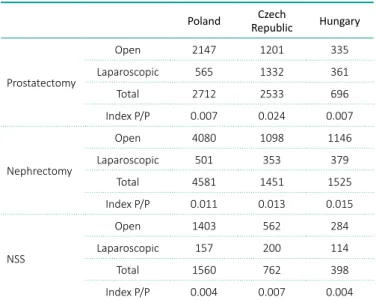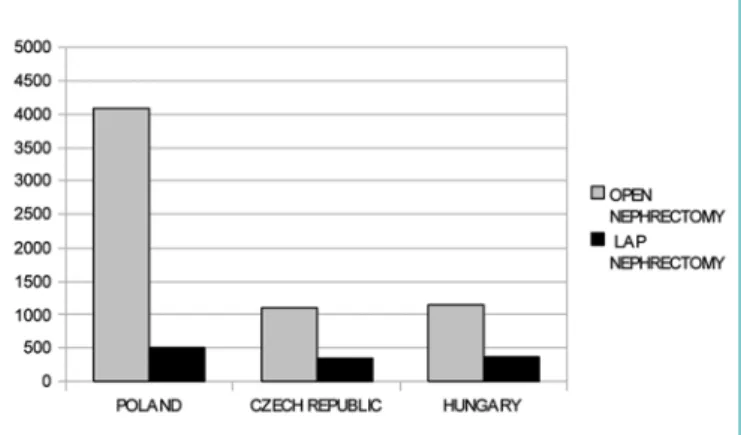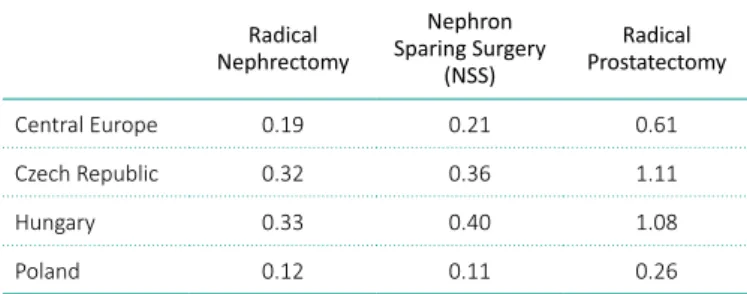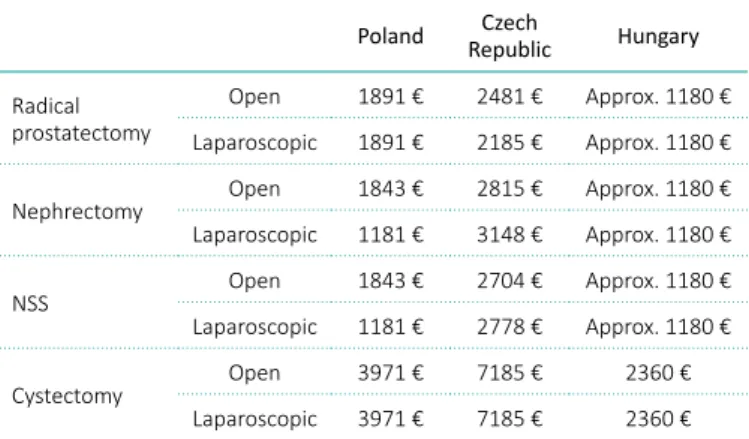O R I G I N A L P A P E R UROLOGICAL ONCOLOGY
Urological procedures in Central Europe and the current reality based on the national registries of Czech Republic, Hungary, and Poland (2012 status)
Przemysław Adamczyk
1, Kajetan Juszczak
2, Tomasz Drewa
1, Milan Hora
3, Peter Nyirády
4, Marek Sosnowski
51Nicolaus Copernicus Hospital in Toruń, Department of General and Oncologic Urology, Toruń, Poland
2Department of Urology, Memorial Rydygier Hospital, Cracow, Poland
3Department of Urology, Faculty Hospital in Pilsen and Faculty of Medicine in Pilsen, Charles University in Prague, Czech Republic
4Department of Urology, Semmelweis University, Budapest, Hungary
5Department of Urology, Medical University, Łódź, Poland
Article history Submitted: July 6, 2016 Accepted: Oct. 22, 2016 Published online: Nov. 30, 2016
Introduction In recent years, the laparoscopic approach in oncologic urology seems more attractable to the surgeons. It is considered to have the same oncologic quality as open surgery, but is less invasive in patients. It is used widely in all of Europe, but with various frequency.
The aim of the study was to present a various amount of oncourological procedures from three neigh- bouring countries – Poland, Czech Republic and Hungary. Prostatectomy, cystectomy, nephrectomy and tumorectomy (Nephron Sparing Procedures – NSS) were presented as a list of procedures prepared from the national registry.
Material and methods The total amount of procedures was presented, as well as the LO (Lap to Open pro- cedures) index, P/P (procedures/population) index, ratio of cystectomy/population, and cystectomy/TURBT.
Results In the Czech Republic, the most complex procedures are performed (laparoscopic/robotic prosta- tectomy, NSS LAP, LAP nephrectomy) in the majority when analysing the country's population. In Hungary and Czech Republic, there are more laparoscopic/robotic radical prostatectomies performed, than open ones. In Poland the largest number of cystectomies is performed when analysing the country's popula- tion, but it is difficult to explain the much higher ratio of 6.57 TUR/one cystectomy. In the Czech Republic this procedure is performed in almost one quarter of the patients (23.36%). Interestingly, in Hungary the cystectomy with pouch creation is performed in about 67.65% cases. The highest reimbursement for sur- gical procedure is present in the Czech Republic with approximately 20–40% more than when compared to Poland or Hungary.
Conclusions The definitive leader in Central Europe (based on the national registry) is the Czech Republic, where the most complex procedures are performed (laparoscopic/robotic prostatectomy, NSS LAP, LAP nephrectomy) in biggest amounts when analysing the country's population. Explanation of such circum- stances, can be the higher reimbursement rate for surgical procedure in this country.
Corresponding author Przemysław Adamczyk Nicolaus Copernicus City Hospital
Department of General and Oncologic Urology 17/19, Batorego Street 87–100 Toruń, Poland phone: +48 606 184 840 przemekad@poczta.onet.pl
Key Words: radical nephrectomy ‹› nephron sparing surgery ‹› upper tract tumors
‹› radical prostatectomy ‹› radical cystectomy and urinary diversion
Cent European J Urol. 2016; 69: 327-333 doi: 10.5173/ceju.2016.886
INTRODUCTION
In surgical oncourology, open approach is still re- garded as a standard management of non-metastat-
ic, invasive and locally advanced urological cancers related to the prostate, kidney, and urinary bladder [1]. However, this approach is associated with clini- cally significant perioperative complications and
Citation: Adamczyk P, Juszczak K, Drewa T, Hora M, Nyirády P, Sosnowski M. Urological procedures in Central Europe and the current reality based on the national registries of Czech Republic, Hungary, and Poland (2012 status). Cent European J Urol. 2016; 69: 327-333.
prolonged recovery time, especially among patients, who are older and often have a history of smoking and coexisting conditions, such as obesity, hyperten- sion, diabetes and many others [2]. Therefore, lapa- roscopic approach which is generally associated with low blood loss, shorter hospital stay and the same level oncologic results, as an open approach, seems more favourable, especially to those with significant comorbidities [3].
We reported the results of the national registries pre- pared by urology consultants representing the Czech Republic, Hungary, and Poland [4]. Unfortunately, a Slovak Republic representative was not able to pre- pare the appropriate data. We reported a total num- ber of procedures in cases of kidney, urinary blad- der and prostate malignancy. Our intention was also to give a view how often surgeons in Central Europe decide to choose laparoscopic/endoscopic approach to treat kidney, prostate, and urinary bladder cancer.
MATERIAL AND METHODS
National registries were analyzed by consultants in urology from the Czech Republic, Hungary, and Poland, and a number of open and endoscopic/lapa- roscopic procedures was calculated for the treatment of prostate, kidney, and urinary bladder cancer.
The period of analysis covered the year of 2012.
The Slovak Republic representative was not able to prepare the appropriate data to compare to those included in the present analysis.
To present the influence of laparoscopic/endoscop- ic technology on surgical skills and preferences, a LO index (Lap to Open procedures) was present- ed. LO index is calculated by the division of the number laparoscopic/endoscopic procedures by the number of open procedures performed for a defined condition. LO indexes were calculated for radical nephrectomy, nephron sparing surgery and radical prostatectomy in each country separately, as well as, for Central Europe.
P/P (procedures/population) index was calculated by division of the number of oncological procedures in total divided by the population of each country, multiplied by 100%, to present the total amount of surgical procedures regarding to the population of the three countries. The total amount of Poland, Czech Republic and Hungary accounted for was 38.5, 10.5 and 10 millions, respectively. It was calcu- lated for cystectomy, prostatectomy (both open and laparoscopic), nephrectomy (both open and laparo- scopic), and kidney nephron sparing surgery.
Ratios of cystectomy/population, cystectomy/
TURBT and cystectomy with pouch/cystectomy were calculated to represent the number of cystec-
Poland Czech
Republic Hungary
Prostatectomy
Open 2147 1201 335
Laparoscopic 565 1332 361
Total 2712 2533 696
Index P/P 0.007 0.024 0.007
Nephrectomy
Open 4080 1098 1146
Laparoscopic 501 353 379
Total 4581 1451 1525
Index P/P 0.011 0.013 0.015
NSS
Open 1403 562 284
Laparoscopic 157 200 114
Total 1560 762 398
Index P/P 0.004 0.007 0.004
tomy procedures regarding to the population of the three countries.
RESULTS
I. Procedures in total
P/P index (procedures/population) was calculated to show the amount of prostatectomy, nephron sparing surgery (NSS) and nephrectomy, regarding the population of the three countries. No major differences were seen in the cases of Poland and
Table 1. P/P (procedures/population) index for the three Cen- tral European countries
Table 2. Ratio of cystectomy/population, and cystectomy/
TURBT for the three countries
Table 3. Ratio of cystectomies with pouch /total number of cystectomies for the three countries
Poland Czech
Republic Hungary
TURBT in total 24325 6678 6327
Cystectomies in total 1598 291 238
Index cystectomies/population 0.004 0.002 0.002
Index cystectomy/TURBT 6.57 4.35 3.76
Poland Czech
Republic Hungary
Cystectomy – pouch 164 68 161
Cystectomies in total 1598 291 238
% of Pouch/Total 10.26 23.36 67.65
Hungary concerning nephrectomy, but big discrep- ancies were seen in the cases of prostatectomy and NSS, where in the Czech Republic it was performed 3.5 and one more time respectively, than in the two other countries (Table 1).
Ratio of cystectomy/population, and cystectomy/
TURBT was calculated to show the total amount of cystectomy procedures, respectively, regarding the population of the 3 countries. No major differences were seen in the case of all three countries concern- ing cystectomies. It is worth noting that in Poland there is a need to perform 6.57 TURBT to perform one cystectomy, when in the case of the Czech Re- public it is 4.35 and in Hungary 3.76 (Table 2).
Ratio of cystectomies with pouch/total number of cystectomies was calculated demonstrating that pouch diversion was created in about 68% of all cys- tectomies in Hungary. In the Czech Republic, pouch diversion was performed more than twice often when compared to Poland (Table 3).
II. Laparoscopy
Kidney and upper tract malignancies
A total number of 10277 procedures was performed due to non-urothelial kidney tumors, while 7557 were radical organ resection and 2720 were organ sparing procedures. Figure 1 presents open and lapa- roscopic nephrectomies, and Figure 2 presents organ sparing procedures (NSS) performed using open ver- sus laparoscopic approach. It was not possible to dis- tinguish laparoscopic transperitoneal approach form retroperitoneal endoscopic kidney surgery.
A total number of 789 nephro-ureterectomies, 210 partial ureter resections, and 84 endoscopic tu- mor ablation/resections were presented in Figure 3.
Laparoscopic and open nephron-ureterectomies were presented together.
Prostate cancer
A total number of 5941 radical prostatectomies were presented in Figure 4. Open approach was used 3683 times, while laparoscopic procedure was performed to treat 2258 patients. It was not possible to distinguish laparoscopic (transabdominal) approach from endo- scopic extraperitoneal radical prostatectomy (EERP).
It is worth noting that the 1128 endoscopic procedures performed in Czech Republic were robot-assisted radi- cal prostatectomies (RARP). Polish and Hungarian registries did not count for any RARP in 2012.
LO indexes (Lap to Open procedures) for radical nephrectomy, nephron sparing surgery and radical prostatectomy are represented in Table 4.
Figure 1. Open versus laparoscopic approach for radical nephrectomy in Central European countries in 2012.
Laparoscopic and retroperitoneal endoscopic kidney surgery were presented together as LAP NEPHRECTOMY.
Figure 2. Open versus laparoscopic approach for organ sparing surgery (NSS – Nephron Sparing Surgery) in Central European countries in 2012. Laparoscopic and retroperitoneal endoscopic kidney surgery were presented together as LAP NSS.
Figure 3. Nephroureterectomies, partial ureter resections and endoscopic tumor ablation/resections in Central European countries in 2012. Laparoscopic and open nephroureterecto- mies were represented together (white bars).
no bigger differences are seen between the three countries, and the proposed index of nephrectomy/
population is not much differerent in any of the countries with the values of 0.011 for Poland, 0.013 for Czech Republic and 0.012 for Hungary.
In Poland more nephrectomies are performed regard- ing the population, probably because the less number of nephron sparing procedures are performed. It is difficult to say, whether location, higher stage of the disease can explain such phenomenon. If it is a case, than ultrasound screening for small renal masses must be worse in Poland when compared to the rest of the countries. The reason of such difference can also be, that in case of Poland and Hungary, urolo- gists decide to choose easier procedures – nephrec- tomy, than more difficult and time consuming – NSS.
In general, NSS/population index is quite similar
Bladder cancer
For the period (2012), it was not possible to distin- guish between open and laparoscopic radical cystec- tomies, so radical and partial cystectomies with uri- nary diversions were presented together. Due to the high number of endoscopic bladder tumor resections (TURBT) in Poland a logarithmic scale was used to better visualize the numbers of all the procedures re- lated to bladder cancer (Figure 5).
DISCUSSION
Many studies indicate that endoscopic/laparoscopic surgery is associated with a reduced risk of complica- tions and shorter hospital stay, when compared with open surgery, but the clinical reality suggests that the open approach is still preferred in some places [5]. In three neighbouring countries, urology seems to be on the same stage of development. Generally, the same procedures were performed, but in dif- ferent numbers, which sometimes can be difficult to explain. It is unfortunate, that the Slovak Repub- lic was not able to provide all data, but hopefully in the immediate future, all the four countries will collect and present data together.
P/P index (procedures/population) for radical nephrectomy and nephron sparing surgery
Radical nephrectomy is a procedure which is intend- ed to be done in each local department of urology, when more difficult and demanding procedures, like prostatectomy or cystectomy can be refereed to more specialized centers [6]. All urologic surgeons have to be familiar with nephrectomy, since the patient with an injured kidney has to be operated on in the local center, not to be transferred [7]. Probably this can be the reason why in the case of nephrectomy, Table 4. LO (Lap to Open procedures) indexes were presented for radical nephrectomy, nephron sparing surgery, and radical prostatectomy. LO index is calculated by division of number laparoscopic/endoscopic procedures by number of open pro- cedures performed for defined condition
Radical Nephrectomy
Nephron Sparing Surgery
(NSS)
Radical Prostatectomy
Central Europe 0.19 0.21 0.61
Czech Republic 0.32 0.36 1.11
Hungary 0.33 0.40 1.08
Poland 0.12 0.11 0.26
Figure 4. Open versus laparoscopic/endoscopic approach for radical prostatectomy in Central European countries in 2012.
Laparoscopic, endoscopic extraperitoneal radical prostatecto- my (EERP), and robot-assisted radical prostatectomies (RARP) were represented together as LAP/ENDOSCOPIC RADICAL PROSTATECTOMY.
Figure 5. Endoscopic bladder tumor resection, radical and partial cystectomies together with urinary diversions in Central European countries in 2012. Logaritmic scale was used to better visualize the numbers of procedures.
be an explanation of why the LO index, in the case of nephrectomy and NSS for Poland, is 0.12 and 0.11 respectively only. It is far better for Czech Republic and Hungary, where the LO index for laparoscopic nephrectomy is 0.32 and 0.33, respectively.
Laparoscopic radical prostatectomy
The same applies for laparoscopic prostatectomy, where it is performed more often in the Czech Re- public and in Hungary, than in Poland (In Czech Re- public and Hungary, the LO index accounts for 1.11 and 1.08, respectively), and only 0.26 for Poland.
It is interesting to note, that in the two countries there are more laparoscopic prostatectomies per- formed than open ones. In Poland almost 80% of all prostatectomies are performed by open approach.
In case of the Czech Republic also robot assisted prostatectomies are accounted into the same group, since this procedure is seldom performed in Poland and Hungary if at all.
Laparoscopic Nephron Sparing Surgery
LO index was also calculated for NSS procedure.
The most difficult, time consuming and demanding kidney procedure is performed in laparoscopic ap- proach respectively 3.5–4 times more often in the Czech Republic and Hungary, than in Poland.
It is difficult to answer, why more complex proce- dures like prostatectomy (especially laparoscopic) and Nephron Sparing Surgery are performed in Po- land and Hungary so sparsely. It may be due to the late diagnosis of prostate and kidney cancer. Both prostate and kidney cancer, are difficult to manage by operation, when found in the higher (cT3-cT4) stage. Therefore, open procedures or radiation ther- apy is applied. It would be also interesting to see how many patients with the diagnosis of prostate cancer are managed by EBRT. This will be described in the next year analysis.
Reimbursement – nephrectomy
Choice of open versus laparoscopic approach and surgery versus radiation therapy could also be explained by the reimbursement. It seems, that government policy in Poland and in Hungary fa- vours open procedures. For example, the National Health Care System in Poland (NFZ), which is an state insurance company, paid 1843€ in 2012 for an open radical nephrectomy, while for laparoscopic radical nephrectomy only 1181€. The plan for 2015 estimates that 1607€ will be given for an open ne- phrectomy, while still a lower reimbursement in Poland, Czech Republic and Hungary, and accounts
for 0.004, 0.007, and 0.004, respectively.
P/P index (procedures/population) for radical prostatectomy
The same applies to another procedure- radical prostatectomy. This procedure is performed in the Czech Republic quite often, and is sparser in Poland and Hungary (P/P index 0.024, 0.007, and 0.007, respectively). It is difficult to answer, whether pa- tients with cancer in Poland and Hungary are found in a higher stage of the disease, than in the Czech Republic, and are referred to radiotherapy treat- ment (EBRT), instead being operated on. It would be interesting to see the amount of radical radiothera- pies for prostate carcinoma in each of the countries, but it seems, that more patients are referred to the radiotherapist, rather than to the urologic sur- geon. It is interesting also because of the expenses involved. In Poland, radical radiotherapy is almost 4 times more expensive than surgery. No such data is available for the rest of the countries. It would be also interesting to count the number of LHRH ago- nists/antagonists prescribed yearly, which is what has to be also be included in the price of EBRT, as it usually is used after procedure.
P/P index (procedures/population) for radical cystectomy in Poland, Czech Republic, and Hungary
In Poland, Czech Republic, and Hungary the P/P in- dex for radical cystectomy accounts for 0.004, 0.002, 0.002. It is interesting to note that the biggest num- ber of cystectomies is performed in Poland, but when taken into in account it is only in 10.26% performed with any type of pouch. In the Czech Republic this procedure is performed in almost one quarter of the patients (23.36%). Interestingly, in Hungary the cys- tectomy with pouch creation is performed in about 67.65% cases.
It is also interesting to note, that in Poland, 6.57 TURBT lead to one cystectomy, whereas in the Czech Republic and Hungary 4.35 and 3.76, respectively.
Laparoscopic nephrectomy
Poland, which is the biggest and most populated of all three countries, has smaller urological depart- ments which cover certain areas of one district.
In such regional departments, laparoscopic procedure is difficult to find, since it is time consuming, difficult to learn as well as to perform. Therefore, it seems that in such places well known open approach is cho- sen, instead of developing new skills. And this can
scopic radical prostatectomy). In the Czech Republic robot-assisted surgery is as popular as an open radi- cal prostatectomy. The Hungarian National Health Insurance does not differentiate between open or laparoscopic radical prostatectomy from a finan- cial point of view, and so the reimbursement is ap- proximately 1000€ per case.
Reimbursement – cystectomy
The National Health Care System (NFZ) in Poland pays equally (3971€) for open and laparoscopic radi- cal cystectomy with urinary diversion. It is so com- parable that there is no force to favour the modern surgery in Poland. The are six centers in Poland (Bydgoszcz, Toruń, Szczecin, Łódź, Kielce, and Cra- cow) where laparoscopic radical cystectomies are per- formed, but because of the same reimbursement for open and laparoscopic radical cystectomy, laparoscop- ic procedures are often reported as radical cystectomy without the discrimination of method. In Hungary there are a very small number of radical cystectomies performed laparoscopically because the length of the operation is longer and the quality of lymphadenec- tomy is debatable. The prize of the operation is a bit less than 1,900 €, which is additionally supported by approximately 800€, as the additional cost of the bowel sewing machine. In the Czech Republic, there is no special signalling or any code for laparoscopic cystectomy, and so the number of laparoscopic cystec- tomies is unknown. But this procedure is relatively rare, accounting for less than 10% of all cystectomies.
The surgery is covered in the RDG system as an open cystectomy, and is paid 3381€.
CONCLUSIONS
The definitive leader in Central Europe (based on the national registry) is the Czech Republic, where the most complex procedures are performed (lapa- roscopic/robotic prostatectomy, NSS LAP, LAP ne- phrectomy) in the biggest amounts, when compared to the country's population.
One explanation of such, can be the higher reim- bursement rate for surgical procedure in this country, which is 20–40% more than in Poland or Hungary.
CONFLICTS OF INTEREST
The authors declare no conflicts of interest.
ACKNOwLEDGMENTS
The authors would like to thank Matyas Benyo M.D., Ph.D., FEBU (Assistant professor – Dept. of UrologyUniversity of Debrecen MHSC) for providing the data of concerning number of open and endoscopic/
laparoscopic procedures done in Hungary in 2012.
of 1181€ will be given for a laparoscopic procedure.
It is obvious that the National Health Care System in Poland prefers open surgery for kidney malig- nancy. This situation looks much better in the Czech Republic and Hungary where treatment options are moving more towards laparoscopic surgery (Table 5).
In Hungary the coding system distinguishes between radical nephrectomy, nephron sparing surgery and also the way of management, open or laparoscopic.
However, there is absolutely no difference in the re- imbursement because there is a fixed prize, which is approximately 1000€. In Hungary there are no robot-assisted procedures in this field, and so there is not an honour of it. In the Czech Republic, open or laparoscopic kidney tumor surgeries are paid by the same base by the DRG (Diagnosis Related Group).
So more expensive laparoscopy is less profitable than the open approach. However, laparoscopic approach is expanding due to the high competition and more- over, stratification of the DRG bases for kidney tumor surgery will be included starting from year 2016.
Reimbursement – Radical prostatectomy
The National Health Care System (NFZ) in Poland pays equally (1891€) for open and laparoscopic radi- cal prostatectomy. These results show that no factors which can favour modern surgery in Poland exist.
It is difficult to implement a new method in any department without financial support. Each new method needs time and money at the beginning.
Again, this situation looks better in the Czech Re- public, but also in Hungry where laparoscopic/endo- scopic approach is preferred for radical prostatecto- my (Figure 4, Table 1). In the Czech Republic, open or laparoscopic radical prostatectomies are paid by the same DRG base. Only robotic-assisted radical prostatectomies are paid to robotic centers with spe- cial fixed compensation (higher than in open/laparo-
Poland Czech
Republic Hungary Radical
prostatectomy
Open 1891 € 2481 € Approx. 1180 € Laparoscopic 1891 € 2185 € Approx. 1180 € Nephrectomy Open 1843 € 2815 € Approx. 1180 € Laparoscopic 1181 € 3148 € Approx. 1180 €
NSS Open 1843 € 2704 € Approx. 1180 €
Laparoscopic 1181 € 2778 € Approx. 1180 €
Cystectomy Open 3971 € 7185 € 2360 €
Laparoscopic 3971 € 7185 € 2360 €
Table 5. Reimbursement in Euro for certain procedures
1. Becker A, Pradel L, Kluth L, et al.
Laparoscopic versus open partial nephrectomy for clinical T1 renal masses: no impact of surgical approach on perioperative complications and long-term postoperative quality of life. World J Urol. 2015; 33: 421-426.
2. Colombo JR Jr, Haber GP, Aron M, Xu M, Gill IS. Laparoscopic partial nephrectomy in obese patients. Urology. 2007; 69:
44-48.
3. Farnham SB, Webster TM, Herrell SD, Smith JA Jr. Intraoperative blood loss
and transfusion requirements for robotic-assisted radical prostatectomy versus radical retropubic prostatectomy.
Urology. 2006; 67: 360-363.
4. Böszörményi-Nagy G. Report of the activity of inpatient care of Hungary according the data of the year 2012. Hungarian Urology. 2014: 26: 27-47.
5. Yu HY, Hevelone ND, Lipsitz SR, Kowalczyk KJ, Hu JC. Use, costs and comparative effectiveness of robotic assisted, laparoscopic
and open urological surgery. J Urol.
2012; 187: 1392-1398.
6. Van Poppel H1, Joniau S, Goethuys H.
Open partial nephrectomy for complex tumours and >4 cm: Is it still the gold standard technique in the minimally invasive era? Arch Esp Urol. 2013; 66:
129-138.
7. McPhee M, Arumainayagam N, Clark M, Burfitt N, DasGupta R. Renal injury management in an urban trauma centre and implications for urological training.
Ann R Coll Surg Engl. 2015; 97: 194-197.



